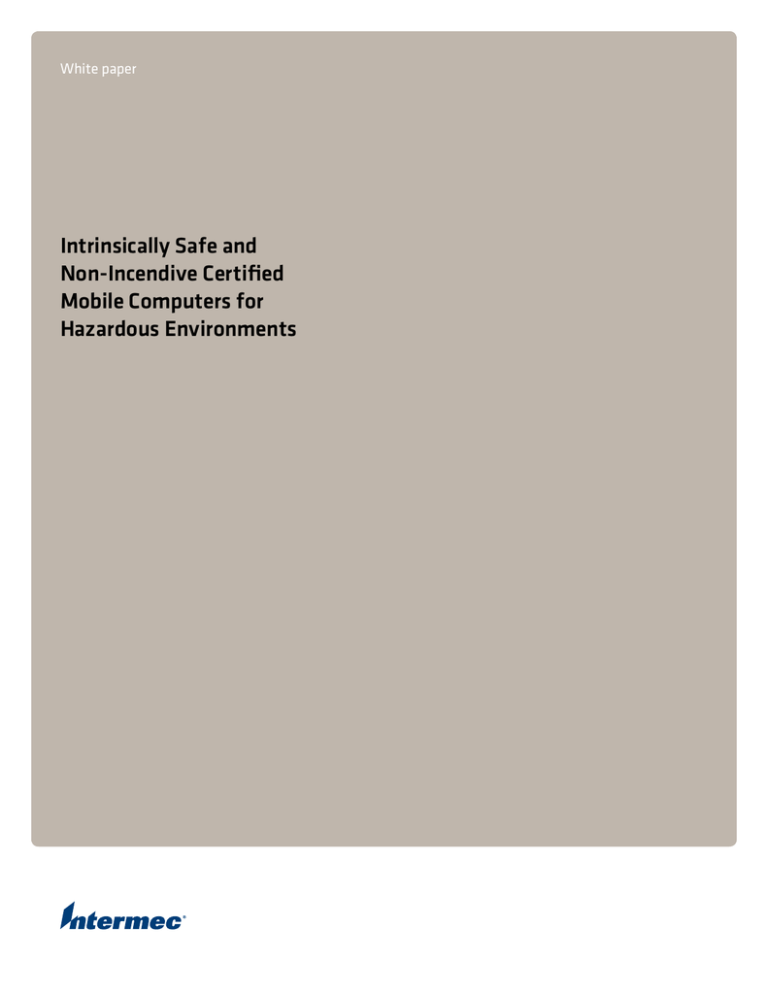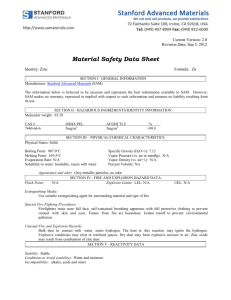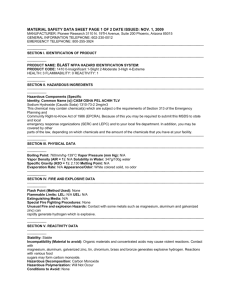
White paper
Intrinsically Safe and
Non-Incendive Certified
Mobile Computers for
Hazardous Environments
Understanding Intrinsically Safe and Non-Incendive Certifications
Keeping workers safe in potentially hazardous environments has
always been a major concern. From the simplicity of the canary in
the coalmines to the latest technologies, providing the optimum
level of safety in hazardous work environments continues to be a
top priority.
Recently, there has been a substantial focus on “intrinsic safety,”
with the European Union’s ATEX regulations taking the lead for
requiring intrinsically safe (I-Safe) devices in potentially explosive
work areas. For the rest of the world, guidelines—like the National
Electrical Code NEC-500—are in place, but are not mandatory.
The specific requirements for any plant operation are under the
control of the plant safety engineer.
What is “Intrinsically Safe?”
Intrinsic safety is a protection standard employed in potentially
explosive atmospheres. Devices that are certified as I-Safe are
designed to be unable to release sufficient energy, by either
thermal or electrical means, to cause ignition of flammable
material (gas or dust/particulates).
Intrinsically safe standards apply to all equipment that can create
one or more of a range of defined potential explosion sources:
•
•
•
•
•
•
•
•
Electrical sparks
Electrical arcs
Flames
Hot surfaces
Static electricity
Electromagnetic radiation
Chemical reactions
Mechanical impact
•
•
•
•
Mechanical friction
Compression ignition
Acoustic energy
Ionizing radiation
What industries are I-Safe products designed for?
· Pharmaceutical
· Chemical
· Oil and Gas
· Petrochemical
· Any environment where explosive gases or particulates are
present
The importance of safety in these environments can’t be stressed
enough. It takes a very small amount of energy to cause an ignition
(e.g. a mixture of hydrogen in air requires only 2OuJ of energy).
Using the right devices minimizes the inherent risk involved in
working around these hazards.
I-Safe versus Non-incendive
Not all hazardous environments require I-Safe certified devices,
even within the same worksite. Some areas may be designated
for non-incendive (NI) certified products instead, while other areas
may be deemed safe for any device.
Because of the significant modifications required to make a
product I-Safe, they are always the most expensive version of a
product, so the secret to designing the optimum suite of devices
for your operation is to identify the safety requirements for
each environment, then purchase products that meet—but don’t
exceed—the safety level necessary as defined by your company’s
plant safety engineer.
It’s rare for every application within an industry to require that
I-Safe devices be used. Below are examples of specific applications
Industry
Factory Floor/
Production
Warehouse/DC
within industries and what level of safety certification they
require.
Yard or outdoor assets
Environment
•
•
•
•
Metal dust possible on factory floor
Gases likely in maintenance
Metal dust possible in air
Gases present in paint shop and
refueling locations
Aerospace
NI possible
No known
requirements
I-Safe required
(maintenance)
Automotive
I-Safe
required
(paint shop)
No known
requirements
No known requirements
• Gases present in paint shop area
• No other know requirement
Chemical, Oil &
Gas
I-Safe
required
I-Safe possible/
NI possible
I-Safe possible/NI
possible
• Gases present in production
• Gases likely in other areas
Electrical Products
No known
requirements
No known
requirements
No known requirements
• No known requirement in any area
Forest Products
I-Safe
required
NI possible
NI possible, but not likely
• Dust present in production
• Dust possible in other areas
Heavy Equipment
I-Safe
required
(paint shop)
No known
requirements
No known requirements
• Gases present in paint shop area
• No other know requirement
Power & Mineral
Production
I-Safe
required
NI possible
No known requirements
• Dust present in production
• Dust possible in other areas
Semiconductors
NI possible
No known
requirements
No known requirements
• Gases possible in production
• No other known requirement
Computers
No known
requirements
No known
requirements
No known requirements
• Dust possible in printer toner plant
Telecom
Equipment
No known
requirements
No known
requirements
No known requirements
• No known requirement in any area
Textiles
I-Safe
required
NI possible
No known requirements
• Fibers present in production
• Possible in warehouse
• No other known requirement
A Systemic Approach to Device Management
Taking a systemic approach to your portfolio of mobile computers
and wireless LANs will provide the right level of safety for workers
while lowering the total cost of ownership. The key factors are:
• Know your work environments
• Don’t over specify the products needed
For example, in the automotive application above you would use
the I-Safe version of an Intermec 730 with I-Safe WLAN antennas
placed within the paint shop, place your WLAN access points
safely outside the shop area, and use standard 730 devices in the
warehouse and yard with standard antennas and access points for
your wireless connectivity.
This systemic approach allows companies to meet their supply
chain management needs with a single suite of products requiring
the same device management and support.
Understanding Certifications
Products that are safe to use in potentially explosive
environments must be tested and certified that they meet the
criteria set by the recognized standards organization in their
region. In the European Union, they are required by law to be ATEX
certified.
The key to choosing the right products is understanding the
certification markings. Below are explanations of ATEX and North
American certification markings.
What is ATEX?
The European intrinsically safe standard, commonly called ATEX
(“Atmosphères Explosibles”), has been set in the European
Union with the 9/94/EC Directive. The stated goal of the
guidelines is to “help ensure the free movement of products in
the European Union” by “minimizing the number of safeguard
clause applications, at least those originating from divergent
interpretations.” 9/94/EC is intended to serve as total
harmonization directive, laying down essential health and safety
requirements, and replacing existing divergent national and
European legislation, which covers the same subjects.
accepted standard. This, in turn, should standardize the
certification nomenclature making it easier for consumers
to understand which products are right for their specific
applications.
The ATEX regulations incorporates standards set by IEC and
CENELEC:
CENELEC (Comité Européen de Normalisation
Electrotechnique or European Committee for
Electrotechnical Standardization) is recognized by the
EC as the European standards organization in its field.
Its objective is to harmonize standards so that sales of
equipment between member nations will not be hindered by
safety requirements. It typically utilizes the IEC standards.
IEC (International Electrotechnical Commission) is
responsible for setting international standards for
electrical technology. Its technical committee TC31 deals
with explosion protection for electrical apparatus. It
has introduced a procedure, the IECEx Scheme, which
is intended to become a globally recognized test and
certification procedure for explosion protection.
You’ll often see European I-Safe certifications referred to as ATEX
/ IEC / CENELC certified.
IECEx reports and certifications are now the only
documentation needed for product certification in Australia
and New Zealand and are rapidly become an internationally Understanding ATEX Certification
Below is a brief explanation of the ATEX certification designations.
ATEX Hazardous Region Categories
Equipment Group II
Non-mining
Category I
Where explosive
atmospheres are present
continuously or for lengthy
periods
Equipment Group I
Mining
Zone 0: A place in which an explosive atmosphere consisting of a mixture of air and flammable
substances (gas, vapor, or mist) is present continuously or for long periods or frequently.
Zone 20 (Dust): A place in which an explosive atmosphere in the form of a cloud of combustible dust in
air is present continuously, or for long periods or frequently.
Zone 1: A place in which an explosive atmosphere consisting of a mixture of air and flammable
substances is likely to occur in normal operation occasionally.
Category II
Where explosive
atmospheres are likely to
occur
Zone 21 (Dust): A place in which an explosive atmosphere in the form of a cloud of combustible dust in
air is likely to occur occasionally in normal operation.
Category III
Where explosive
atmospheres are likely to
occur infrequently and be of
short duration
Zone 2: A place in which an explosive atmosphere consisting of a mixture of air and flammable
substances is not likely to occur in normal operation but, if it does occur, will persist for a short period
only.
Zone 22 (Dust): A place in which an explosive atmosphere in the form of a cloud of combustible dust in
the air is not likely to occur in normal operation but if it does occur, will persist for a short period only.
Group II - Gasses
Group IIC
(acetylene & hydrogen)
T1
450˚C
T2
300˚C
Group IIB
(ethylene)
T3
200˚C
Temperature Classes
T4
135˚C
Group IIA
(propane)
T5
100˚C
T6
85˚C
For example, the Intermec 700 color hand held computer carries
several ATEX / IEC / CENELEC certification at the same
time, these certification “strings” are shown below:
II 1 G EEx ia IIB T4
I M 1 EEx ia I
II 3 G EEx nL IIC T6
Approval Marking
The ATEX examination mark. This sign is required on all devices used in European hazardous areas.
Classification
of Zones
II 1 G
IM1
II 3 G
The classification of zones. For the first certification “string” “II” designates the equipment is
approved for all non-mining areas. (zone “I” is for mining areas) “0” represents the CENELEC zone
category of the device, in this case the device is rated for the most hazardous or Zone 0 areas. “G”
designates atmosphere, in this case gas, vapors, and mist. The second certification string “I” and
“M1” designates that the device is suitable for use in mining applications subject to fire damp
(methane gas). The third string designates that the unit is approved for use in similar applications as
the first string but the 3 indicates it is for use in Zone 2 rated areas.
Regulation
EEx
Explosion protection based on the CENELEC European ex-regulations.
Type Of Protection
Ia
nL
The type of protection from explosion. In the first instance the protection method is intrinsic safety
using two fault analysis, which qualified the device for use in Zone 0 applications. In the second
instance the protection method is type ‘n’ and specifically non-sparking.
Explosion Groups
IIB
I
IIC
Non-mining equipment, gas group. “IIB” are rated safe for areas where gas groups IIB or IIA are
present. “I” are rated safe for mining applications subject to fire damp. “IIC” are rated safe for areas
where gas groups IIC, IIB or IIA are present.
Temperature Class
T4
Temperature class gives the user the maximum temperature of a surface that may be in contact to
the ex-atmosphere under fault conditions. T4 is rated at 135º C.
Understanding NEC-500 Classification
The NFPA (National Fire Protection Association) 70, National
Electrical Code, also known as the NEC, is the basis for all electrical
codes in the United States. Classifications and related product
markings for hazardous areas are covered in NEC 500 and 505.
These are similar to, but not exactly the same as those in ATEX.
There are several organizations that certify products for NEC-500
compliance, including:
Factory Mutual (FM) Global, a not-for-profit scientific and testing
organization that has tested and certified over 40,000 products in
the last 165 years. FM Research has set certification guidelines for
equipment used in potentially explosive atmospheres.
UL (Underwriters Laboratory), the leader in product safety testing
and certification in the U.S. UL provides I-Safe certification for the
U.S. and Canada.
North American Hazardous Region Categories
Division 1: Hazard expected to always be present. Requires I-Safe equipment.
Division 2: Hazard not expected to be present, except as a result of a malfunction. I-Safe or NI equipment can be used.
Class III
Fibers
Group G
Other dusts (corn,
skimmed milk, wheat
flour, sorbic acid, sulfur,
aspirin, vitamin B1,
vitamin C, plastic resin, or
Group F
Carbonaceous dust
(Carbon Black, Charcoal,
Coal, or similar)
Group E
Metal dust (Aluminum,
Magnesium, or similar)
Group D
Acetone, Ammonia, Butane,
Ethanol, Methane, Natural
Gas, Propane, Gasoline, or
similar
Class II
Dust
Group C
Ethyl Ether, Ethylene,
Carbon Monoxide,
Nitromethane, or similar
Group B
Hydrogen, Butadiene,
Ethylene Oxide, Propylene
Oxide, Aorolein, or similar
Group A
(Acetylene)
Class I
Gasses
Temperature Classes
(similar to ATEX, but with subgroups for classes T2. T3, & T4)
Type of protection
N.I.
Non-incendive apparatus, internal energy is limited so a spark will
not be generated by its use.
For example, the Intermec 700 Color hand held computer carries a
U.S and Canada certification of:
I.S.
Intrinsically Safe Apparatus.
I-Safe Class I, Div. 1, Groups C, D; T4
N.I. Class 1, Div 2, Groups A-D, T6
Inaddition it carries a US only approval rating of:
N.I. Class I, Div. 2, Groups F, G
The Factory Mutual Approved mark.
UL listing marks for US and Canada. There is a separate organization that is UL Canada who
uses a different logo. The smaller logo on the right designates that the product has been
tested to the Canadian requirements. A different form of this logo is allowed if both the US
and Canadian requirements have been met. This logo is the encircled UL mark with the letter ‘c’
located in the 8 o’clock position as shown and ‘us’ located in the 4 o’clock position.
Approval
Marking
The Canadian Standards Association (CSA) Approved mark.
Type Of
Protection
N.I.
Classification
Of
Combustibles
Class I
Divisions
Groups
Div 2
Groups A-D
Non-incendive apparatus, internal energy is limited so a spark will not be generated by its use.
For use with gases, vapors and liquids (not dust, fibers or filings).
Certified for use in Division 2 (Flammable material present abnormally).
Rated for use in Zone 2 with explosive gasses as defined by groups A-D, including acetylene,
hydrogen, acetylene and propane.
Associated apparatus
Another classification of product is an “associated apparatus,”
which may contain elements of a protection system, but the
device itself lives outside the hazardous environment.
The Right Degree Of Safety
Keeping workers safe in potentially hazardous areas is not new,
but the advent of mobile devices in those areas has added a new
level complexity.
For example, wireless LAN access points do not need to be
certified safe as they reside outside the hazardous area. On the
other hand, the WLAN antennas must be certified and a control
drawing established to guide the installation of the associated
apparatus to ensure the circuit remains rated as I-Safe or NI.
Before determining the ratings necessary for your specific
environment, have your plant safety engineer define the necessary
requirements. By taking a systemic approach to managing mobile
computers and wireless networks, and understanding safety
certifications, you can specify products with the right level of
safety for each area within the enterprise. The results will be a
lower total cost of ownership, simplified device management and
support, and—most importantly—a safer, more productive work
environment.
Associated apparatus certification marks are designated by
brackets around the certification rating.
North America
Corporate Headquarters
6001 36th Avenue West
Everett, Washington 98203
Phone: (425) 348-2600
Fax: (425) 355-9551
South America & Mexico
Headquarters Office
Newport Beach, California
Phone: (949) 955-0785
Fax: (949) 756-8782
Europe/Middle East &
Africa Headquarters Office
Reading, United Kingdom
Phone: +44 118 923 0800
Fax: +44 118 923 0801
Sales
Toll Free NA: (800) 934-3163
Toll in NA : (425) 348-2726
Freephone ROW: 00 800 4488 8844
Toll ROW : +44 134 435 0296
Asia Pacific
Headquarters Office
Singapore
Phone: +65 6303 2100
Fax: +65 6303 2199
OEM Sales
Phone: (425) 348-2762
Internet
www.intermec.com
Worldwide Locations:
www.intermec.com/locations
Customer Service and Support
Toll Free NA: (800) 755-5505
Toll in NA : (425) 356-1799
Media Sales
Phone: (513) 874-5882
Copyright © 2007 Intermec Technologies Corporation. All rights reserved.
Intermec is a registered trademark of Intermec Technologies Corporation. All other
trademarks are the property of their respective owners. Printed in the U.S.A.
611588-01C 02/07
In a continuing effort to improve our products, Intermec Technologies Corporation
reserves the right to change specifications and features without prior notice.



